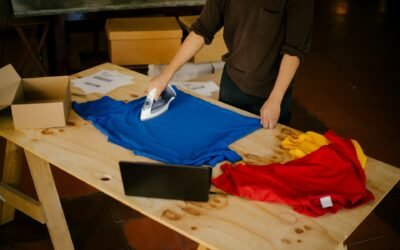Keeping your sustainable t-shirts in great condition is more than just a matter of style; it’s about preserving the hard work and ethical values that went into making them. Sustainable t-shirts are designed with the environment in mind, and maintaining them helps extend their life and reduces waste. While these eco-friendly garments are crafted to last, they can still face common wear and tear issues, like loose threads, that can affect their appearance and longevity.
Loose threads might not seem like a huge deal at first, but if you leave them untreated, they can cause seams to come undone, leading to bigger repairs or even the need to replace the shirt. In this guide, we’ll explore how you can easily identify loose threads on your favorite t-shirts and the simple ways to fix them, ensuring your sustainable wardrobe stays in tip-top shape for as long as possible.
Identifying Loose Threads
Spotting loose threads before they become a bigger issue is key to preventing damage to your t-shirt. Start by giving your t-shirt a quick once-over after each wash. Look along the seams and edges, as these are the most common spots where threads tend to unravel. If you notice any threads sticking out or feeling loose to the touch, it’s time to take action.
When it comes to inspecting new t-shirts, be proactive. Before you throw on that newly acquired favorite tee, spend a few moments checking for potential weak spots. Gently run your fingers along the seams and tug lightly at any loose threads to see if they start to unravel. Catching these early can save you time and energy in the long run. Also, take note of how the stitching looks—tight and even stitches generally mean fewer issues down the road.
Tools You’ll Need
Experienced or not, fixing loose threads is a simple task when you have the right tools on hand. Here’s a quick checklist of what you’ll need:
– Needle: A basic sewing needle will work perfectly for threading those loose ends back into place.
– Thread: Match your thread color with the t-shirt for a seamless, concealed repair.
– Scissors: Use sharp scissors to trim any excess thread after the repair is complete.
The needle allows you to precisely weave the loose threads back into the fabric, while matching thread ensures that your repair blends in. Keeping a small sewing kit at home can be handy for just this kind of quick fix, making the repair process straightforward and stress-free.
These tools don’t just solve the immediate problem; they help maintain your t-shirt’s quality and extend its life, aligning with the sustainable values you care about. With these simple supplies, you’ll be ready to tackle loose threads in no time, keeping your sustainable t-shirts in excellent condition.
Step-By-Step Guide to Fixing Loose Threads
Once you’ve gathered your necessary tools, fixing loose threads is straightforward. Begin by threading your needle. This is the starting point for most sewing tasks and might take a few attempts if you’re new to it. Simply cut a piece of thread about 18 inches long, wet the end to make it easier to handle, and guide it through the eye of the needle. Knot one end of the thread to secure it.
Next, it’s time to reinforce the seam where the loose thread is causing trouble. Begin by inserting the needle close to the base where the thread is loose. Gently weave the needle back and forth along the seam, following the pattern of the existing stitches. This will help tighten the gap and keep the fabric intact. Take care not to pull too tightly, as this might cause puckering or additional strain on the material.
Finally, you’ll want to secure your work to ensure it’s as durable as possible. Tie a knot at the end of your sewing to lock everything in place. Trim any excess thread with your scissors, being careful not to cut too closely to the seam. Check the repaired area by lightly tugging it to confirm that everything is held securely.
Preventative Care for Sustainable T-Shirts
While fixing loose threads can ensure your t-shirts look their best, taking steps to prevent them can save time and effort. Start by paying attention to your washing routine. Turn your t-shirts inside out before placing them in the washing machine. This reduces friction on the external surfaces and protects the seams from unnecessary wear.
Drying is equally important. Avoid the high heat of a tumble dryer, as it can weaken the fibers and cause stitching to loosen. Instead, air drying on a flat surface or a clothesline can help maintain the shape and integrity of your t-shirts. If you must use a dryer, choose a low-heat setting to minimize damage.
Proper storage also goes a long way in preserving your garments. Instead of cramming t-shirts into a drawer, fold them neatly or hang them on hangers with enough space between each to prevent squeezing or pulling. Keeping mothballs or cedar blocks nearby can help ward off unwanted pests that may harm the fabric.
Keep Your T-Shirts Looking Great
Taking care of your sustainable t-shirts is a gesture of respect for both the environment and the craftsmanship that went into making them. These simple practices not only ensure your favorite tees look fresh but also contribute to a longer lifespan, which is a core principle of sustainability. By regularly maintaining and repairing your clothes, you actively reduce waste and lessen the demand for new resources.
Remember to treat your wardrobe with care, just like you would any valuable item. By fixing loose threads early and adopting some simple preventative measures, you’ll keep your t-shirts in excellent condition and stay aligned with your values. Implement these techniques to make the most out of your sustainable clothing collection.
Extend the life of your wardrobe and make a positive impact on the planet by choosing sustainable t-shirts that align with your values. Explore the options at Save Mother Earth and find styles that not only look great but also support environmental conservation efforts.









